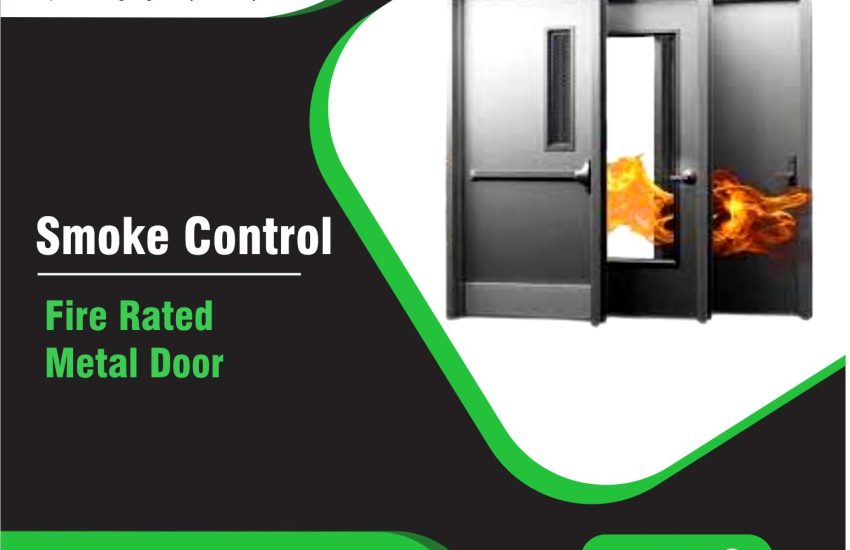Fire Rated Metal Door are crucial for providing fire protection in buildings. They help prevent the spread of fire, smoke, and heat, protecting both occupants and property. These doors are often made of steel or aluminum and are designed to meet specific fire-resistance standards. In this article, we’ll explore the specifications, benefits, and features of fire-rated metal doors to help you understand their importance and choose the right one for your needs.
What Is a Fire Rated Metal Door?
A fire-rated metal door is designed to resist the spread of fire for a specified period, usually measured in hours. These doors are typically made of steel, aluminum, or composite materials, and feature a fire-resistant core. The fire resistance rating varies based on the type of door and the materials used. The most common ratings are 30 minutes (FD30), 60 minutes (FD60), and 90 minutes (FD90), but some doors offer up to 3-hour ratings (FD180). These doors are installed in critical areas like stairwells, hallways, and fire exits to ensure safety during an emergency.
Key Specifications of Fire Rated Metal Doors
When selecting a fire-rated metal door, several key specifications are important to ensure you meet building codes and fire safety requirements.
1. Fire Resistance Rating
The fire resistance rating indicates how long the door can withstand fire and prevent it from spreading. The higher the rating, the longer the door will protect against heat and flames. Common ratings include:
- FD30: 30 minutes of fire resistance
- FD60: 60 minutes of fire resistance
- FD90: 90 minutes of fire resistance
- FD180: 3 hours of fire resistance
Select a fire-rated door based on the fire risk of the area and local building regulations.
2. Material Composition
Fire-rated metal doors are commonly made from steel, aluminum, or composite materials. The fire-resistant core plays a crucial role in enhancing the door’s ability to resist fire. Some common cores include:
- Honeycomb Core: Provides strength and heat resistance.
- Mineral Core: Offers excellent fire protection.
- Intumescent Core: Expands when exposed to heat, forming a barrier to fire and smoke.
3. Size and Thickness
Fire-rated doors come in various sizes, but the most common thickness is around 1-3/4 inches to 2-1/4 inches. The size of the door should meet the requirements of the building’s design. Custom sizes are available to suit specific installation needs.
4. Frame Construction
A fire-rated door frame should be made of steel or aluminum to ensure it provides a secure seal against fire and smoke. Proper frame installation is essential to the door’s performance during a fire.
5. Hardware and Accessories
The hardware on a fire-rated metal door, such as fire-rated hinges, locks, and panic bars, must be rated to withstand high temperatures. Additionally, features like automatic closing devices and gaskets ensure that the door seals tightly when closed, maintaining its fire-resistance capabilities.
Benefits of Fire Rated Metal Doors
Fire-rated metal doors offer several advantages that make them an essential component of a building’s fire safety plan.
1. Fire Safety and Protection
The primary benefit of fire-rated metal doors is their ability to contain fire and smoke, preventing them from spreading to other parts of the building. This containment increases the time occupants have to evacuate safely and minimizes property damage.
2. Security
Metal doors are strong and resistant to forced entry. These doors provide both fire protection and security, making them ideal for areas that require both.
3. Durability and Longevity
Fire-rated metal doors are highly durable and long-lasting. They resist wear and tear, and they require minimal maintenance. Their robust construction makes them ideal for high-traffic areas or commercial buildings.
4. Compliance with Safety Codes
Installing fire-rated metal doors ensures compliance with building codes and fire safety regulations, such as UL 10C, NFPA 80, and EN 1634. This helps reduce legal liabilities and ensures the safety of the building’s occupants.
5. Noise Reduction and Insulation
Many fire-rated metal doors also offer thermal insulation and soundproofing features, making them ideal for areas that need temperature control and noise reduction. The insulation helps reduce heat transfer, while soundproofing is beneficial in environments like offices and hospitals.
Applications of Fire Rated Metal Doors
Fire-rated metal doors are used in a variety of applications, from commercial buildings to residential properties. Some common areas where they are installed include:
- Commercial Buildings: Fire-rated doors are essential in office buildings, shopping malls, and schools to prevent the spread of fire.
- Industrial Facilities: Manufacturing plants and warehouses often use fire-rated doors to protect machinery and reduce fire risks.
- Residential Buildings: In multi-family homes and apartment buildings, fire-rated metal doors are installed between living spaces and shared hallways to protect residents.
- Healthcare Facilities: Hospitals and healthcare facilities use fire-rated doors to create fire-resistant barriers in critical areas like operating rooms and patient wards.
How to Choose the Right Fire Rated Metal Door
Selecting the right fire-rated metal door involves several factors. First, determine the fire resistance rating required for the specific area. Next, consider the door’s material, size, and frame to ensure it meets both the building’s requirements and safety standards. Additionally, assess the hardware and accessories to ensure they are fire-rated and suitable for the intended use.
Lastly, always ensure that the door is certified and compliant with fire safety regulations. Fire-rated metal doors must pass specific fire tests, such as UL 10C or NFPA 80, to guarantee they provide adequate protection during a fire.
Conclusion
Fire-rated metal doors are a critical part of any building’s fire safety system. With various specifications and benefits, these doors provide essential fire protection, security, and compliance with building codes. By understanding the specifications and benefits of fire-rated metal doors, you can make an informed decision about the right door for your building.


